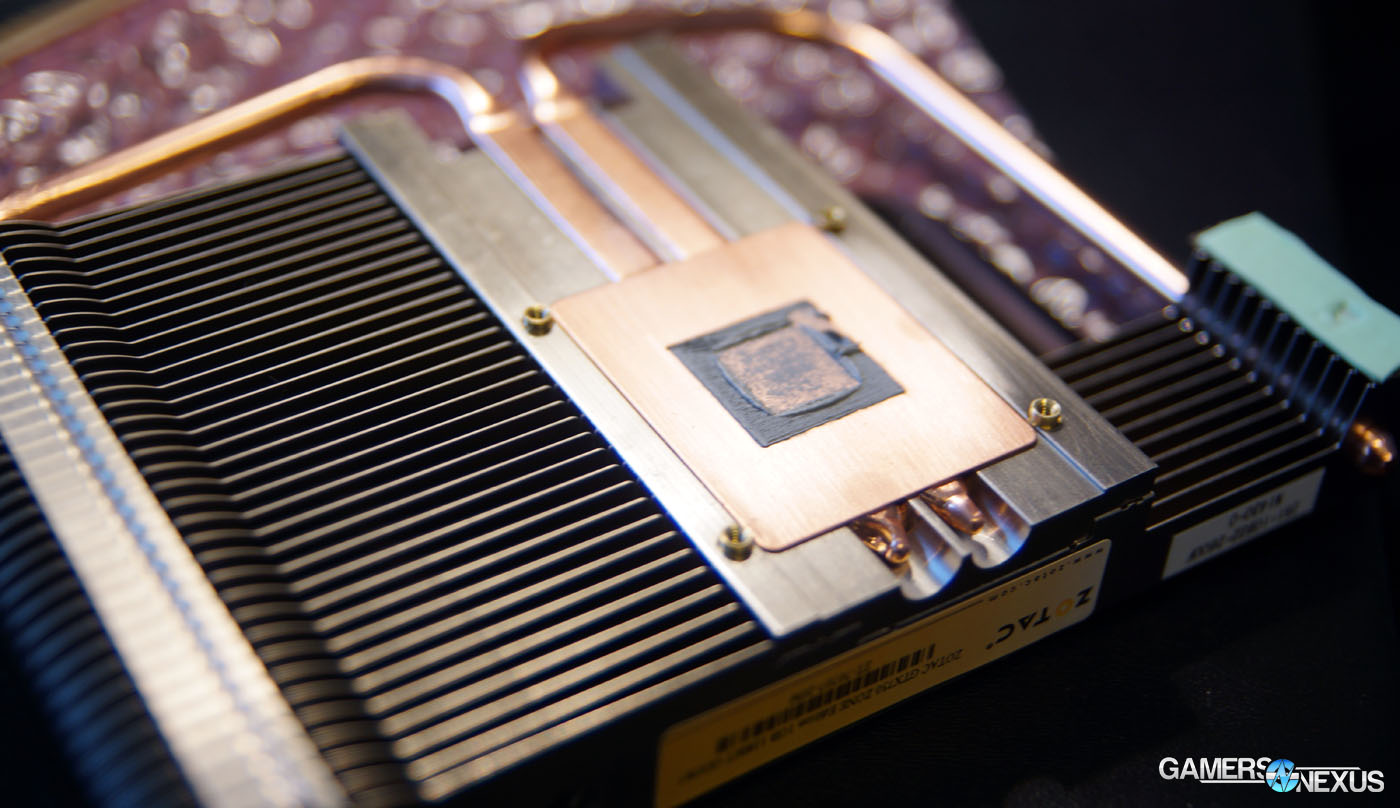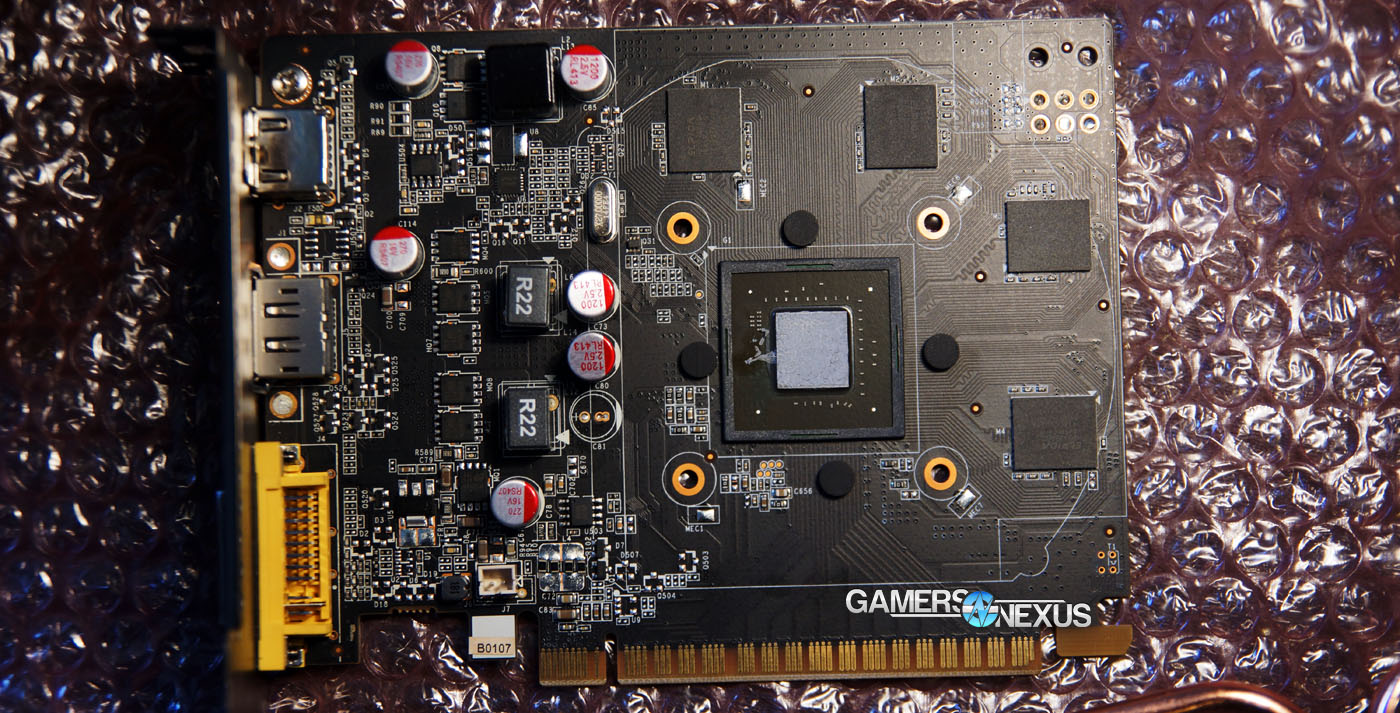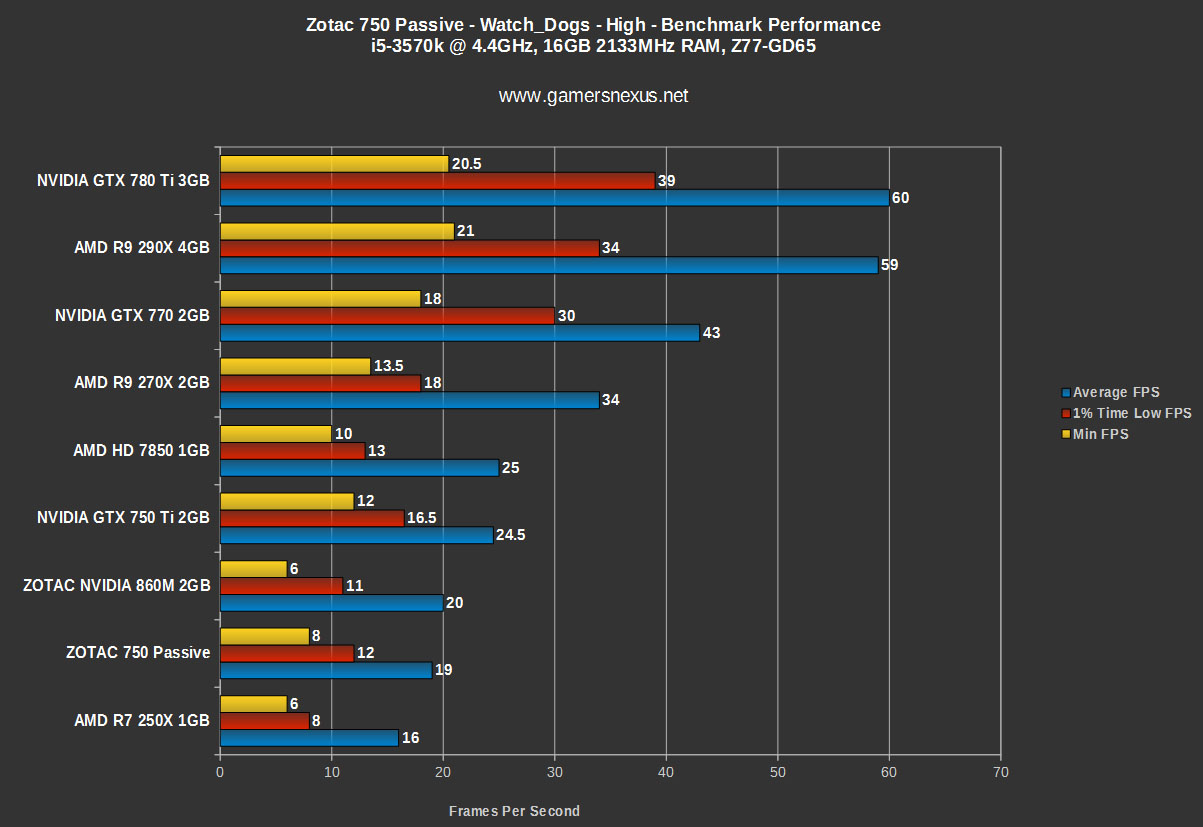We remarked upon the GTX 750 / 750 Ti reveal that passive cards were a distinct possibility, given the low TDP and ability of the cards to operate solely on motherboard PCI-e power. Hovering at a 55W TDP, nVidia’s GM107-powered GTX 750 doesn’t draw any power from the PSU and has a lower thermal footprint than any of its higher-powered brethren. With the right heatsink design, it’s always been an ideal candidate for a passively-cooled, silent, low-profile HTPC video card.
ZOTAC announced its “GTX 750 ZONE” passively-cooled solution just a few weeks ago. Standard GTX 750 specs apply, the one exception being that Zotac has nixed the active fan in favor of a larger aluminum and copper heatsink with no active components. Thermals are always a concern when operating a passively-cooled device, and with GPUs, thermals will directly impact the throttling and performance (FPS) output in games.
We benchmarked Zotac’s passive GTX 750 Zone video card for temperatures and framerate (FPS) in Metro, GRID, Battlefield 4, Titanfall, Watch_Dogs, and FurMark. These results can be extrapolated upon for a wider-spectrum understanding of the GPU’s worth for gaming.
Zotac GTX 750 ZONE Specs
| GPU | NVidia GTX 750 (GM107) |
| Clocks | 1033MHz BCLK 1111MHz Boost CLK |
| CUDA Cores | 512 |
| Memory Spec | 1GB GDDR5 5000MHz Mem CLK 128-bit interface |
| Output | 1xDL-DVI 1xHDMI 1xDisplayPort |
| Cooling | Passive |
ZOTAC GTX 750 ZONE FPS Benchmark, Video Review, Gameplay
Looking at the GTX 750 ZONE
The video card is pretty standard-issue when it comes to accessories. You get the box, the card, a DVI/VGA adapter, and that’s about it. As with all GTX 750 devices, the ZONE is limited to 1GB of GDDR5 RAM, though this will be plenty of memory for HTPC users. The card will be more limited by the GPU’s computational performance than the memory at this point, anyway, and it’s really not meant for higher-end gaming than what a 1GB capacity can fuel.
Priced at $120, MSRP is just above what most GTX 750 active cards are selling for and just under the $140 GTX 750 Ti 2GB (active) card. Passive cards always bear with them some added cost over a reference design, but you’re paying for silence and slightly lower TDP.
How Does Passive GPU Cooling Work?
We haven’t discussed how a passive GPU cooler works before, though we’ve explained CPU heatsinks in complete detail. The methodology is identical.
For ease of understanding, here’s a photo of the 750 ZONE when disassembled:
A copper coldplate is mounted directly to the GPU, secured only by four screws on the rear side of the circuit board. The coldplate, as seen above, has thermal compound residue on it that matches up with the thermalpaste residue on the actual GPU (which is the small piece of silicon mounted to the board). This is the point of contact.
The copper coldplate conducts the heat away from the GPU with direct contact, using the thermalpaste as a means to aid in smoothing out the divets in the surface of the copper (TIM has a higher thermal conductivity than air, which is what would fill any imperfections if TIM were not present). Copper has a thermal conductivity (measured in Watts per Meter Kelvin) of nearly 400W/mK at 25C. Aluminum is approximately half of that, and for reference, thermal compound (TIM) tends to sit in the 4-8W/mK range.
Once the heat has been conducted to the coldplate by the copper’s natural thermal conductivity, the heatpipes begin their work. I previously made a graphic to describe how heatpipes work -- you can read that full article here (as already linked above).
What’s going on here is phase changing and basic physics. The heatpipes contain a small liquid (coolant) that would be exposed if cut open with a hacksaw. This liquid undergoes a phase change when heated by the heat conducted away from the GPU, turning it into a gas. Capillary action does its work as the gas moves to the opposite end of the copper heatpipe, condenses in the tip, and cycles back toward the GPU in liquid form to be reused. As the gas and liquid moves throughout the copper heatpipes (two, in the case of the 750 ZONE), the encasing aluminum fins from the larger heatsink help duct heat from the copper pipes (heat wants to spread outward and disperse). This cools down the pipes and liquid, allowing the recondensing into liquid.
It appears that the ZOTAC 750 ZONE has a third machined hole for another heatpipe, but there isn’t one there -- maybe it was deemed unnecessary.
The aluminum fins then must be cooled to ensure efficiency as the card continues to heat up. Normally, this is where the fan would come in -- the fan forces air through the heatsink to pull heat away from the fins as cooler air passes through. In the case of a passive solution, we’re relying primarily on static air in the environment or intake from case fans. Our test bench uses the Phantom 820, so the ZONE has several large (200mm+) fans pointed directly at it. The air from this intake is what cools the fins, which cool the heatpipes, which cool the coldplate, which cools the GPU.
This is almost a perfect system with no noteworthy loss of liquid, so it will effectively supersede the usable life of the GPU several times over.
Continue on to page 2 for the benchmark charts, FPS, and thermals!
Test Methodology
Our standard test methodology applies here. For thermal benchmarking, we deployed FurMark to place the GPU under 100% load while logging thermals with HW Monitor+. FurMark executed its included 1080p burn-in test for this synthetic thermal benchmarking. In FPS and game benchmark performance testing, we used the following titles:
- Metro: Last Light Benchmark.
- GRID: Autosport Benchmark.
- Battlefield 4 Gameplay.
- Titanfall Gameplay.
- Watch_Dogs Gameplay.
FRAPS was used to log frametime and framerate performance during a 120 second session. FRAFS was used for analysis. Tests were conducted three times for parity.
NVidia 340.43 beta drivers were used for all tests conducted on nVidia's GPUs. The 340.43 beta introduced performance improvements specifically for GRID. AMD 14.7 drivers were used for the AMD cards, which contain no notes of GRID-specific improvements.
| GN Test Bench 2013 | Name | Courtesy Of | Cost |
| Video Card | (This is what we're testing). | ZOTAC. | $120 |
| CPU | Intel i5-3570k CPU Intel i7-4770K CPU (alternative bench). | GamersNexus CyberPower | ~$220 |
| Memory | 16GB Kingston HyperX Genesis 10th Anniv. @ 2400MHz | Kingston Tech. | ~$117 |
| Motherboard | MSI Z77A-GD65 OC Board | GamersNexus | ~$160 |
| Power Supply | NZXT HALE90 V2 | NZXT | Pending |
| SSD | Kingston 240GB HyperX 3K SSD | Kingston Tech. | ~$205 |
| Optical Drive | ASUS Optical Drive | GamersNexus | ~$20 |
| Case | Phantom 820 | NZXT | ~$130 |
| CPU Cooler | Thermaltake Frio Advanced | Thermaltake | ~$65 |
The system was kept in a constant thermal environment (21C - 22C at all times) while under test. 4x4GB memory modules were kept overclocked at 2133MHz. All case fans were set to 100% speed and automated fan control settings were disabled for purposes of test consistency and thermal stability.
A 120Hz display was connected for purposes of ensuring frame throttles were a non-issue. The native resolution of the display is 1920x1080. V-Sync was completely disabled for this test.
The video cards tested include:
- AMD Radeon R9 290X 4GB (provided by CyberPower).
- AMD Radeon R9 270X 2GB (we're using reference; provided by AMD).
- AMD Radeon HD 7850 1GB (bought by GamersNexus).
- AMD Radeon R7 250X 1GB (equivalent to HD 7770; provided by AMD).
- NVidia GTX 780 Ti 3GB (provided by nVidia).
- NVidia GTX 780 3GB x 2 (provided by ZOTAC).
- NVidia GTX 770 2GB (we're using reference; provided by nVidia).
- NVidia GTX 750 Ti Superclocked 2GB (provided by nVidia).
GTX 750 Passive Temperatures vs. GTX 750 Ti, 250X, & Other Active Coolers
Unfortunately, we don’t have an active GTX 750 on-hand for comparison -- but we’ve got a lot of other video cards. I only ran a few of our suite through the thermal bench for this review. We’re looking at the 750 ZONE (passive) vs. the GTX 750 Ti, 250X, 780 Ti (flagship), and 290X (flagship). Afterburner was used to modify fan speeds. Fans were allowed to run at “auto” during one pass, then set to 100% for the second pass (to normalize results). Auto will be more indicative of real-world use, whereas 100% is indicative of absolute performance of the cooling interface.
Lower is better.
The GTX 750’s passive cooling solution is impressive. The card sat at around 29.8C (adjusted for ambient) when under 100% load. Idle was just 2C above ambient. The 750 Ti -- a slightly more powerful card with an active solution -- rests closer to 32C when under load. Putting things into perspective, the 750 ZONE is sitting at a temperature that’s probably just below what the average CPU would be reporting depending on the cooling solution and load. That’s what we want. In a small HTPC, the cooling performance will be appreciated greatly by neighboring components.
FPS Game Benchmark: GTX 750 ZONE vs. 750 Ti, 250X, 770, 270X, etc.
Let’s get into the game benchmarks. These are all fairly self-explanatory. Higher is better. GN internally defines 60FPS as “playable” for modern games.
Metro: Last Light - GTX 750 Benchmark
Metro: Last Light is one of the most graphically-intensive games on the market right now and includes an industry-accepted benchmarking suite. The GTX 750 ZONE operates at just under 30FPS when the game is played on “Very High” with “High” tessellation, jumping to 35FPS when on “High” with “Normal” tessellation. Considering that the 250X is comparably-priced and falls below this, with the 750 Ti performing 23% better than the 750, performance is really not that bad. You’d have to run Metro on a mix of medium/low settings to approach 60FPS, but considering this is one of the most stressing games, our ~$100 card is doing well.
GRID: Autosport - GTX 750 Benchmark
As we’ve written many times before, GRID: Autosport is one of the best-optimized (new) games on the market right now.
The 750 ZONE outperforms the 860M and 250X again, this time sitting close to 40FPS average when on maxed-out settings. Dropping down to the “High” preset, we see performance increase to an impressive 78FPS average. More than playable. You’d be able to run GRID: Autosport on a mix of high/ultra with the 750 card, even though it’s passively cooled.
Battlefield 4 - GTX 750 Benchmark
Battlefield 4 -- like Metro -- is one of the most graphics-intensive games on the market. Every time I return to the bench, I’m impressed with the realistic lighting, shading, and liquid physics effects. That doesn’t make a good game, of course, but it makes a great real-world benchmarking tool.
On the “Ultra” preset, the 1GB GTX 750 ZONE operates at just over 30FPS average, again ranking above the 860M and 250X. Performance is slightly below the 750 Ti 2GB solution, which hovers closer to 40FPS.
Dropping to “High,” we see the ZONE and 250X trade places with minimal performance gain on the nVidia card. You’d have to run Battlefield 4 on a mix of low/medium to adequately play at a consistent 60FPS with a full server. Not the greatest, but also not unexpected.
Titanfall - GTX 750 Benchmark
We benchmarked Titanfall at launch and noted that it was one of the most horridly-optimized PC games in recent history, surpassed only by the next title we tested. Things have improved a bit with driver updates and patches, thankfully.
Despite its poor optimization, Titanfall isn’t a very intensive game on the GPU. Performance sits around 50FPS with the 750, 860M, and 7850 when on “High” settings. The 750 retains significantly better 1% and 0.1% time FPS over the mobile 860M, but that’s about the only noteworthy difference.
You’d hit a constant 60FPS if mixing “High” and “Medium” settings, perhaps with a texture resolution drop.
Watch_Dogs - GTX 750 Benchmark
And now we get to the worst-optimized game we’ve ever tested. This one was bad.
Note first that even the 780 Ti struggles to get to 60FPS in Watch_Dogs on High settings. That understood, the 750 sits at a completely unplayable 19FPS. This is more a fault of Watch_Dogs than anything, as evidenced by poor performance across the board, but the game is popular enough to warrant testing. You’d be on low settings, definitely, and I’m not even sure if that’d be consistently playable at 60FPS. Maybe with AA completely disabled.
Conclusion: The Passive GTX 750 is Impressive, but Has Limits
We walked away impressed with thermal performance given the passive ‘sink. NVidia built the GPU specifically to enable passive cooling solutions, and with ZOTAC, Palit, EVGA, and others finally building cards without fans, it looks like the world is ready for silent gaming HTPCs.
Gaming performance is about on-par with what we’ve come to expect with the GTX 750, but holds strong even when passively cooled. Again, impressive performance given the cost, cooling, low-TDP, and tiny nature of the card / GPU. GRID: Autosport strikes me as an ideal HTPC game, and at nearly 80FPS on High, it’s more than playable on the 750.
Ultimately, the GTX 750 Ti ($140) would be significantly better value (dollars-per-frame) over the GTX 750 ZONE ($120), but you’re not going to get a cheap GTX 750 Ti with a passive cooler. For anyone building an HTPC that aims to sustain dead-silence, a passive video card is the best option without relying on an IGP. There exist passive 750 Ti cards, but the cost just isn’t there for budget HTPCs.
If you’re looking for dead-silence in a relatively cool, moderately-performing GPU for home theater PC use, the GTX 750 ZONE stands as a strong contender. If you can live with the normal noise a fan produces, consider the GTX 750 Ti.
- Steve “Lelldorianx” Burke.













